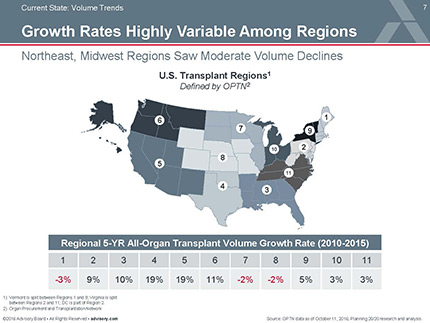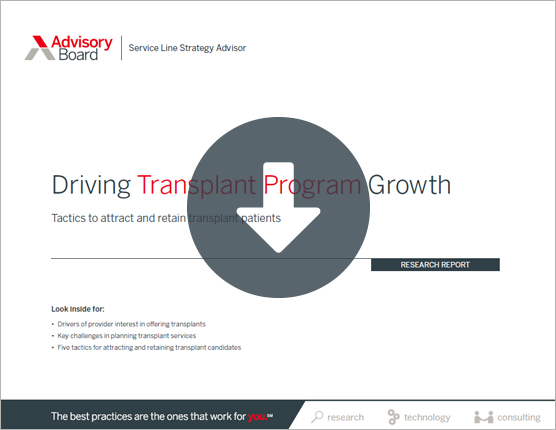Auto logout in seconds.
Continue LogoutFourteen transplant centers and four transplant patients on Tuesday filed a lawsuit against HHS and the United Network for Organ Sharing (UNOS) over a new liver allocation policy that would allocate liver transplants by distance to the donor instead of region, Modern Healthcare reports.
Here are 5 key tactics to attract and retain transplant patients
The lawsuit comes after the transplant centers in 2018 sent a letter to HRSA asking that the agency not implement the new policy.
Background
The United States currently is divided into 11 regions in which livers are allocated by need. Under the current system, livers are first offered to the sickest patient within the region where the liver becomes available. Transplant patients are given a so-called MELD score, estimating their current risk of death, which is based on a 40-point scale. If a there is no match for a liver within the region where it was donated, the liver can be distributed to other regions.
In some instances, a patient in one region could be on the verge of death before he or she qualifies for a liver, while comparatively healthier patients receive livers in other regions.
To address the issue, the Organ Procurement and Transplantation Network (OPTN), which oversees organ distribution, and UNOS in December 2018 approved a new liver distribution policy intended to prioritize patients with the most urgent medical needs and reduce geographic disparities in the distribution of livers for transplant.
Under the new policy, livers donated from individuals who are at least 70 years old or who die from cardiorespiratory-related issues would first go to patients who live within 500 nautical miles of the donor hospital and have the most urgent medical need. After those patients, such livers then would go to patients with a MELD or PELD score of 15 or higher who are located within 150 miles of the donor hospital.
In addition, livers donated from individuals who are younger than 18 would first go to liver candidates younger than age 18 who are located within a 500 nautical-mile radius of the donor hospital.
According to OPTN/UNOS, "Simulation modeling … suggests [the new policy] will reduce pre-transplant deaths and increase access for liver transplant candidates younger than age 18." UNOS estimated fewer than 50 liver candidates across the United States would qualify as priority patients "at any given moment" under the new policy.
The lawsuit
The transplant centers that filed the lawsuit—which include Emory University Hospital, Piedmont Hospital, the University of Michigan, and the University of Kansas Hospital Authority—argue, however, that the changes will put patients' lives at risk and will result in "hundreds of liver transplant candidates needlessly dying."
The centers alleged that HHS' decision to allow UNOS to determine the nation's liver allocation policy is unlawful, KSMU reports, adding that the new policy is "the product of an opaque, reckless process that failed to allow for full public comment and transparent discussion."
The lawsuit states that, "[b]ased on the government's own data," transplant centers under the new policy will perform 256 fewer transplants per year and at least 20% fewer liver transplants in "the most socioeconomically disadvantaged regions in the country."
According to the plaintiffs, performing fewer transplants each year would leave more than 200 candidates "at risk of imminent death absent the transplant they would have otherwise received."
The plaintiffs requested that HHS and UNOS strike down the new policy and "develop a policy that complies with the law."
Comments
HHS said it would delay implementing the policy, which was set to take effect next week, to allow time for the judge to consider the case, Modern Healthcare reports.
Ann Paschke, a spokesperson for UNOS, in a statement said the organization would review the lawsuit but maintained that the new policy is "a step in the right direction," adding that it will "provid[e] a fairer, more equitable system for all liver patients." Paschke said that "the new policy is projected to reduce waitlist mortality by roughly 100 fewer deaths each year, will allow more children to receive life-saving transplants, and will correct an inequity that … led to unfair advantages and disadvantages based on where liver transplant recipients live."
However, Sen. Roy Blunt (R-Miss.) in the St. Louis Post-Dispatch last week said the new policy would prevent donated livers from staying within regions that have a higher rate of donor registration, like the Midwest and the South, adding that the policy "rewards locations that don't have [a] high number of organ donors."
The University of Kansas Hospital, a plaintiff in the lawsuit, also said the new policy would force transplant teams to transport organs up to 500 miles away from each donor hospital, which would increase risk for patients, the organs, and the teams, and hike up transportation costs.
"More people will die. … [T]hat's the bottom line," Sean Kumer, a transplant surgeon at the University of Kansas Hospital, said in the statement.
Patients awaiting a transplant have posted on the public comment forum on OPTN's website to express their opposition to the new policy, according to Modern Healthcare. One commenter, Timothy Marcum who is on the transplant list for the Mayo Clinic and Vanderbilt University, said he "will die before [he gets] a liver transplant," under the new policy (Luthi, Modern Healthcare, 4/24; Margolies, KSMU, 4/24; Ramm, The Gazette, 4/24).
Here are 5 key tactics to attract and retain transplant patients
Download this briefing to learn how to expand the pipeline of potential transplant patients and engage them across the care pathway.
Don't miss out on the latest Advisory Board insights
Create your free account to access 1 resource, including the latest research and webinars.
Want access without creating an account?
You have 1 free members-only resource remaining this month.
1 free members-only resources remaining
1 free members-only resources remaining
You've reached your limit of free insights
Become a member to access all of Advisory Board's resources, events, and experts
Never miss out on the latest innovative health care content tailored to you.
Benefits include:
You've reached your limit of free insights
Become a member to access all of Advisory Board's resources, events, and experts
Never miss out on the latest innovative health care content tailored to you.
Benefits include:
This content is available through your Curated Research partnership with Advisory Board. Click on ‘view this resource’ to read the full piece
Email ask@advisory.com to learn more
Click on ‘Become a Member’ to learn about the benefits of a Full-Access partnership with Advisory Board
Never miss out on the latest innovative health care content tailored to you.
Benefits Include:
This is for members only. Learn more.
Click on ‘Become a Member’ to learn about the benefits of a Full-Access partnership with Advisory Board
Never miss out on the latest innovative health care content tailored to you.


